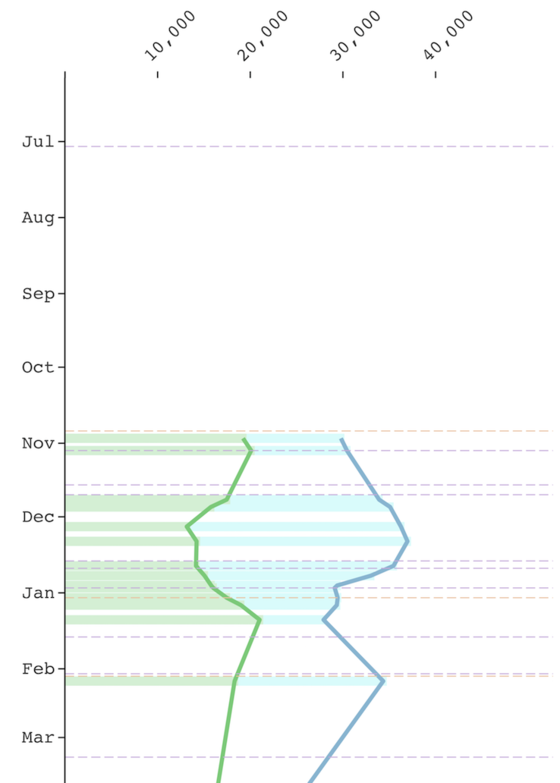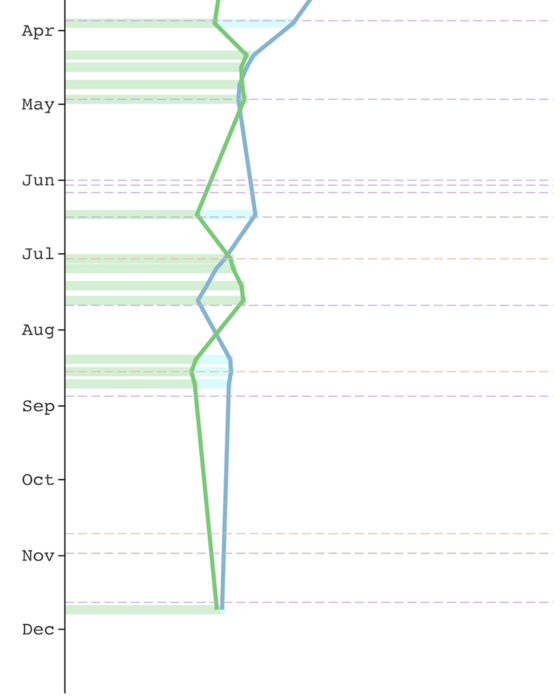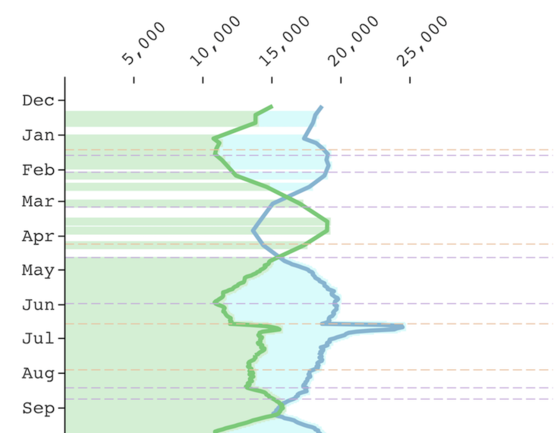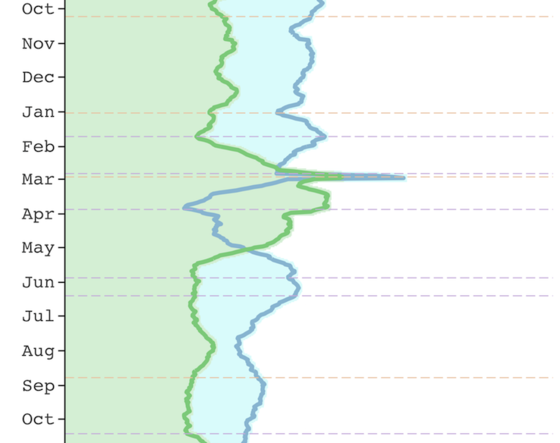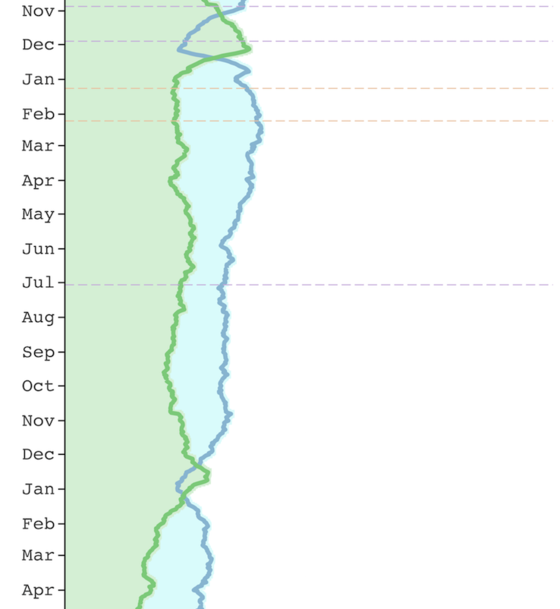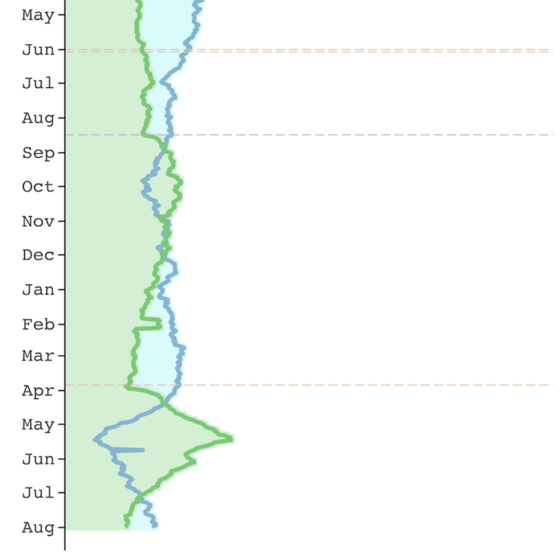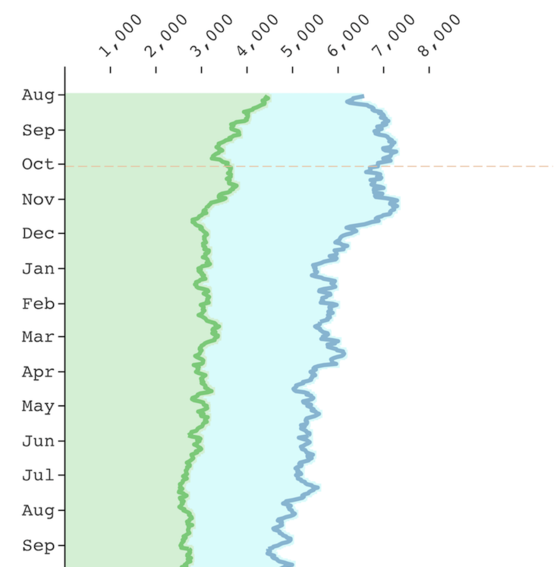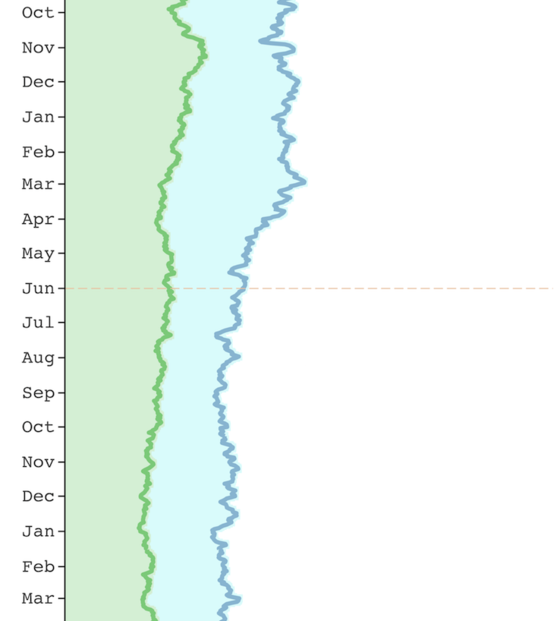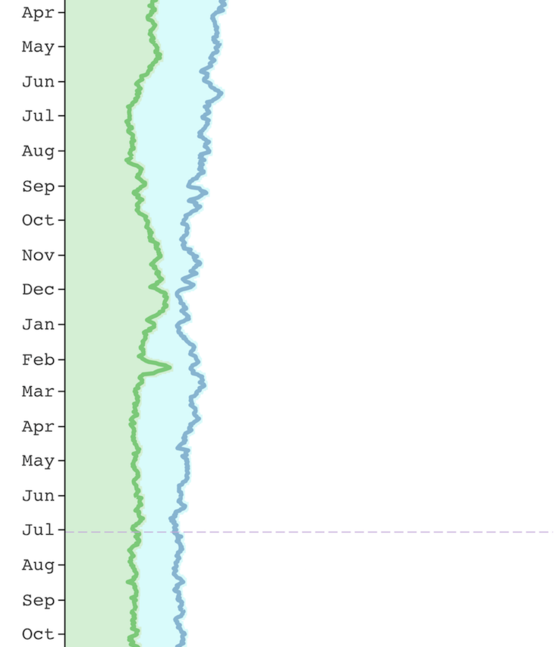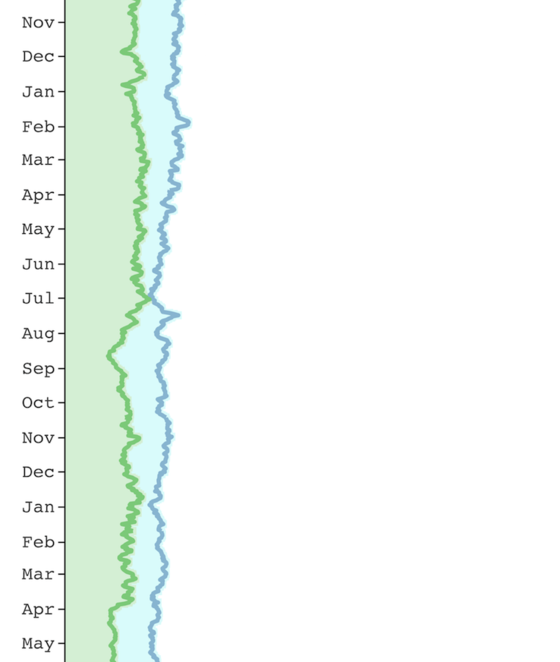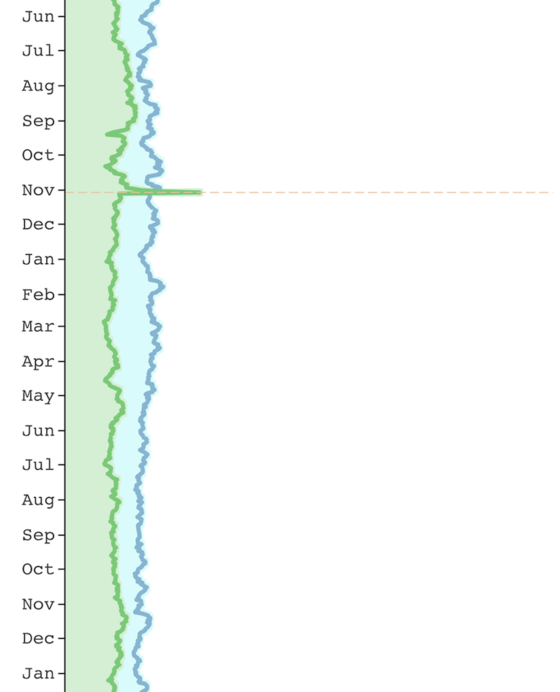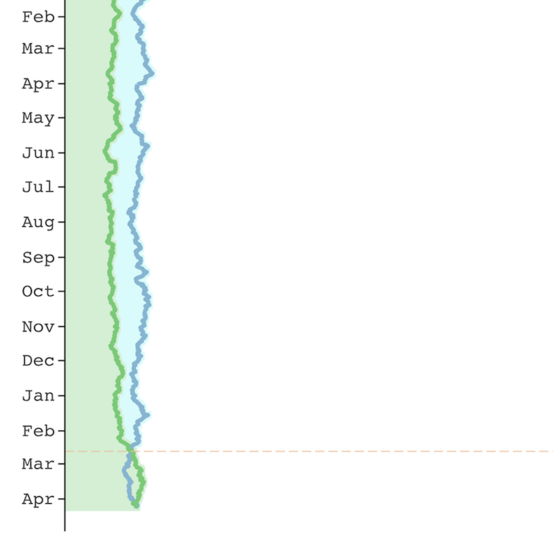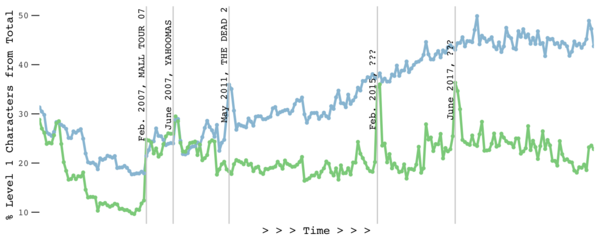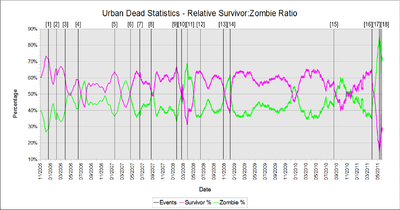Survivor-Zombie Imbalance: Difference between revisions
mNo edit summary |
m (language) |
||
| (12 intermediate revisions by the same user not shown) | |||
| Line 1: | Line 1: | ||
<div style="position:fixed; left:10; background-color:white; padding:.5em">[[Survivor-Zombie Imbalance#1|'''TOP''']]<br>[[Survivor-Zombie Imbalance#2|'''INFO''']]<br>[[Survivor-Zombie Imbalance#3|'''CAV''']]<br>[[Survivor-Zombie Imbalance#4|'''WHY''']]<br><br>[[Survivor-Zombie Imbalance#5|'''EDV''']]<br><font color='lightgrey'>2005<br>2006</font><br><br>[[Survivor-Zombie Imbalance#6|'''TS''']]<br>[[Survivor-Zombie Imbalance#.C2.A02007|2007]]<br>[[Survivor-Zombie Imbalance#.C2.A02008|2008]]<br>[[Survivor-Zombie Imbalance#.C2.A02009|2009]]<br>[[Survivor-Zombie Imbalance#.C2.A02010|2010]]<br>[[Survivor-Zombie Imbalance#.C2.A02011|2011]]<br><br>[[Survivor-Zombie Imbalance#7|'''TLT''']]<br>[[Survivor-Zombie Imbalance#2012|2012]]<br>[[Survivor-Zombie Imbalance#.C2.A02013|2013]]<br>[[Survivor-Zombie Imbalance#.C2.A02014|2014]]<br>[[Survivor-Zombie Imbalance#.C2.A02015|2015]]<br>[[Survivor-Zombie Imbalance#.C2.A02016|2016]]<br>[[Survivor-Zombie Imbalance#.C2.A02017|2017]]<br>[[Survivor-Zombie Imbalance#.C2.A02018|2018]]<br>[[Survivor-Zombie Imbalance#.C2.A02019|2019]]<br>[[Survivor-Zombie Imbalance#.C2.A02020|2020]]<br><br>[[Survivor-Zombie Imbalance#8|'''CONC''']]</div> | |||
=====<font color='white'>1</font>===== | =====<font color='white'>1</font>===== | ||
{| | {| | ||
| Line 148: | Line 149: | ||
=== <span style='line-height:8px'>'''2007'''</span>=== | === <span style='line-height:8px'>'''2007'''</span>=== | ||
{| style='padding-top: | {| style='padding-top:6px' | ||
|'''January 14th, 19th & February 3rd.''' [[Mall Tour '07]] begins. New skills enables zombies to detect [[Scent Blood|infected survivors]] and [[Scent Death|locate nearby horde members]]. Around this time, [[X:00]] tactics is developed. In early February, zombies get XP for de-barricading, ransacking buildings, and destroying machinery. | |'''January 14th, 19th & February 3rd.''' [[Mall Tour '07]] begins. New skills enables zombies to detect [[Scent Blood|infected survivors]] and [[Scent Death|locate nearby horde members]]. Around this time, [[X:00]] tactics is developed. In early February, zombies get XP for de-barricading, ransacking buildings, and destroying machinery. | ||
|- | |||
|'''March 6th.''' Survivors begin the useless pastime of collecting and exhibiting [[decorations|museum decorations]]. | |||
|} | |} | ||
| Line 161: | Line 164: | ||
{| style='padding-top:0px' | {| style='padding-top:0px' | ||
|'''June 18th.''' Yahoo publishes an article on Urban Dead, prompting over 10,000 players to join in days. Clueless level 1 survivors wander the streets, eaten and idling out in the coming weeks. | |'''June 18th.''' [[Yahoomas|Yahoo]] publishes an article on Urban Dead, prompting over 10,000 players to join in days. Clueless level 1 survivors wander the streets, eaten and idling out in the coming weeks. | ||
|} | |} | ||
| Line 179: | Line 182: | ||
=== <span style='line-height:0px'>'''2008'''</span>=== | === <span style='line-height:0px'>'''2008'''</span>=== | ||
{| style='padding-top:9px' | {| style='padding-top:9px' | ||
|'''January 2nd & 23rd.''' The Second Big Bash hits a month long [[Battle of Pitneybank|siege at Pitneybank]]. A controversial and incredibly | |'''January 2nd & 23rd.''' The Second Big Bash hits a month long [[Battle of Pitneybank|siege at Pitneybank]]. A controversial and incredibly influential game update in the third week of fighting, [[interference|barricade interference]], makes holding [[Giddings Mall]] and other tactical locations against the [[Beachhead Tactic|zombie beachheads]] untenable. <br/>'''February 25th & 28th.''' While a second city, [[Monroeville]], opens, a massive, [[The Dead|world-ending horde]] fuelled by an [[Wikipedia:Something Awful|external forum]] [[March of The Dead|marches on the city]]. The survivor population drops to 31%, the lowest to-date. <br/>'''March 28th.''' [[Monroeville]] is quarantined, blocking character creation. Headshot becomes permanent. | ||
|} | |} | ||
| Line 256: | Line 259: | ||
<div style="width:560px">The lack of player events and game updates stagnates the game. It also provides convincing evidence that the "default" ratio is about three survivors for every two zombies, or about 60% survivors and 40% zombies. That is, unless something disrupts it.</div> | <div style="width:560px">The lack of player events and game updates stagnates the game. It also provides convincing evidence that the "default" ratio is about three survivors for every two zombies, or about 60% survivors and 40% zombies. That is, unless something disrupts it.</div> | ||
|- | |- | ||
| width='100px' | [[File:threeone.png|560px]][[File:threetwo.png|560px]][[File:threethree.png|560px]][[File:threefour.png|560px]][[File:threefive.png|560px]][[File:threesix.png|560px]] || style="vertical-align: top; width:600px;position:absolute" | | | width='100px' | [[File:threeone.png|560px]][[File:threetwo.png|560px]][[File:threethree.png|560px]][[File:threefour.png|560px]][[File:threefive.png|560px]][[File:threesix.png|560px]] || style="vertical-align: top;width:600px;position:absolute" | | ||
| Line 267: | Line 270: | ||
{| style='padding-top:43px' | {| style='padding-top:43px' | ||
|'''October 3rd.''' Malton | |'''October 3rd.''' Malton sees its last [[Mall Tour '11|mall tour]]. Although the late stage of the game tempers the size of the horde, survivors fare far worse. The malls—nearly empty, nearly ruined, or ruined already—fall easily to the horde. | ||
|- | |- | ||
|<font color='white'>1</font> | |<font color='white'>1</font> | ||
=== | ==='''2012'''=== | ||
The first year in Urban Dead's history when nothing in particular happens. At least according to this graph, anyway. | |||
|} | |} | ||
| Line 303: | Line 306: | ||
=== '''2013'''=== | === '''2013'''=== | ||
<font color='white'>.</font> | <font color='white'>.</font> | ||
{| style='padding-top: | {| style='padding-top:105px' | ||
|'''June 1st.''' [[Big Bash 4|The Big Bash 4]], the last bash and the last player event on this graph. This Bash is gravely concerned for survivor safety; survivors, who for a moment believe the zombies have their best interests in mind, quickly realize the zombies feel they are ''too'' safe. In other words, many zombies eat many survivors. | |'''June 1st.''' [[Big Bash 4|The Big Bash 4]], the last bash and the last player event on this graph. This Bash is gravely concerned for survivor safety; survivors, who for a moment believe the zombies have their best interests in mind, quickly realize the zombies feel they are ''too'' safe. In other words, many zombies eat many survivors. | ||
|} | |} | ||
| Line 479: | Line 482: | ||
The opinion of this author: the ratio favours survivors because they have more things to do and are more fun to play. The [[Action Points|AP]] efficiency of actions is secondary to this. The fact that players choose the side they want to play damages the idea that AP efficiency is the cause for the relative overabundance of survivors... with the exception of the few and far between [[Dual Nature]] players. | The opinion of this author: the ratio favours survivors because they have more things to do and are more fun to play. The [[Action Points|AP]] efficiency of actions is secondary to this. The fact that players choose the side they want to play damages the idea that AP efficiency is the cause for the relative overabundance of survivors... with the exception of the few and far between [[Dual Nature]] players. | ||
Consider game [[Wikipedia:chemical equilibrium|equilibrium]]. Whenever a survivor is killed, they become zombies until they are revived. The rate at which survivors go through this process depends on how much AP it takes to kill them, | Consider game [[Wikipedia:chemical equilibrium|equilibrium]]. Whenever a survivor is killed, they become zombies until they are revived. The rate at which survivors go through this process depends on how much AP it takes to kill them, find syringes, find survivors to revive, and then revive them. But the game balance cannot be reduced to the math of AP efficiency. If dead survivors ''want'' to be alive, they [[Mrh Cow|go to revive points]], get revived, and try not to die again. This increases the rate at which survivors are revived, but it is based on player preference rather than the direct cost of AP. To drive the point home, if every player suddenly decides they only want to be zombies, then they purchase [[brain rot]] or jump out of buildings. This would greatly slow the rate at which zombies become survivors, increasing the relative abundance of zombies. If we really wanted to know how balanced the game is from an AP efficiency perspective, everyone would need to play as Dual Nature. | ||
<Big><big><big>'''ZERGING'''</BIG></big></big> | |||
[[file:Level 1 graph.png|600px]] | |||
<div style="width:600px;text-align:left"> | |||
<big>'''Plot showing the percentage of level 1 characters compared to all other levels.'''</big><br> | |||
Level 1 characters include survivors (all classes) in blue and zombies in green. Time is scaled "loosely" because the data was obtained from the Wayback Machine; each data point is not necessarily separated by equal amounts of time. However, the data begins in late 2005 and ends in early 2021. | |||
Keep in mind that level 1 characters can be legitimately created as alts or by players new to the game, as well as en masse by zergers. Given the waning popularity of the game, fewer new players are expected to join. Therefore, the later timepoints more likely reflect efforts by zergers. | |||
A crude interpretation of this graph is that players have zerged more as time has gone on, especially by using survivor alts. A more nuanced position is that the zerging tends to be in the form of throwaway level 1 survivors, rather than zombies. The main exception are several spikes in level 1 zombies (some marked on the graph), which disappear either from banning or levelling up. | |||
</div> | |||
| Line 490: | Line 510: | ||
| [[File:UD-SZI-Relative-Graph.png|November 2005 to May 2011 relative graph. By using the percentage of each, one can see changes independent of the ever changing total active population and some effects which are more well hidden on the absolute values become obvious here.|thumb|400px]] || [[File:UD-SZI-Absolute-Graph.png|November 2005 to May 2011 absolute graph. This shows the actual changes in standing numbers over time, the magnitude of keys events can be seen easily.|thumb|400px]] | | [[File:UD-SZI-Relative-Graph.png|November 2005 to May 2011 relative graph. By using the percentage of each, one can see changes independent of the ever changing total active population and some effects which are more well hidden on the absolute values become obvious here.|thumb|400px]] || [[File:UD-SZI-Absolute-Graph.png|November 2005 to May 2011 absolute graph. This shows the actual changes in standing numbers over time, the magnitude of keys events can be seen easily.|thumb|400px]] | ||
|} | |} | ||
<Big><big><big>'''SEE ALSO'''</BIG></big></big> | <Big><big><big>'''SEE ALSO'''</BIG></big></big> | ||
| Line 506: | Line 528: | ||
* [http://www.urbandead.com/stats.csv Game Statistics Log] for comprehensive data post April 22, 2007 | * [http://www.urbandead.com/stats.csv Game Statistics Log] for comprehensive data post April 22, 2007 | ||
* [http://web.archive.org/web/*/http://www.urbandead.com/stats.html Wayback Machine] for sporadic data pre April 22, 2007 | * [http://web.archive.org/web/*/http://www.urbandead.com/stats.html Wayback Machine] for sporadic data pre April 22, 2007 | ||
__NOTOC__ | |||
__NOEDITSECTION__ | __NOEDITSECTION__ | ||
[[Category:Statistics]] | |||
[[Category:History]] | |||
Latest revision as of 20:51, 30 July 2022
1
| ........... | 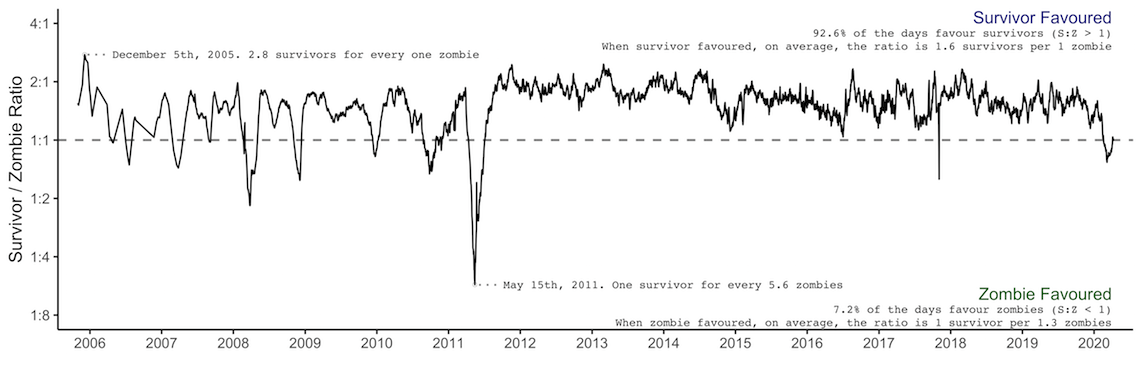
The Survivor / Zombie Ratio, December 2005 to April 2020. Data obtained from Urban Dead statistics, April 2017 to current day. Older data from the Wayback Machine was collected manually.3
2INTERPRETING THE GRAPHS The first graph shows the survivor-zombie ratio. The graph below shows the absolute survivor and zombie populations in a series of three parts: Early Day Volatility (EDV), The Swings (TW), and The Long Tail (TLT).4 These graphs go in-depth, listing most game updates and a small number of player-initiated events. While the game updates are listed regardless of their impact on the survivor-zombie ratio, partly due to the relative infrequency of the updates, the player events are (usually) listed if they seem to be responsible for a shift in the survivor-zombie ratio. An underlying assumption is that the ratio only changes if a force acts on it, be it a game update or player event. Although it often seems "obvious" that a game update or player event caused a shift in the ratio, it is impossible to identify all player events occurring at a given time; not all have been written into history. And given a specific time point, multiple events could be happening at the same time. How do we determine the degree to which each event influenced the ratio? Sometimes, however, an event is so large that it undeniably caused a change in the ratio. Call it a natural experiment. All that said, the purpose of the following in-depth graph is to chronicle the game balance over the years, without pointing too many fingers. 3CAVEATS
4WHY ISN'T [INSERT EVENT HERE] ON THE GRAPH? The graph maker may have missed an important game event (and it should be included). But it's also important to minimize the number of events and game updates on the page, as there's only so much room available. Larger scale events, such as roaming hordes and "big picture" moments in history (e.g., protests) are typically included. While some events clearly had no impact on the ratio, such as The Big Bash 4, they are still listed here. This is mainly included for the reader's interest, since the earlier versions of events tended to have a stronger impact. A few second city events are included for interest, even though their respective populations are not present in Malton's statistics. Some of the simpler or cosmetic game updates are also not mentioned, such as bug fixes, server upgrades, and unofficial changes (example).
5EARLY DAY VOLATILITY The first year or so of Urban Dead's history was marked by rapid game updates, establishing fundamental mechanics that flattened the ratio close to equality. These changes came quickly on the heels of social upheaval, the kind consisting of protests, violent riots, and roaming zombie hordes. It was an energetic, though uncertain time.
8CONCLUSION The ratio stabilized as time went on. By The Long Tail, there were three survivors for every two zombies. (To be precise, it's an average of 1.55 survivors per zombie over the entire game history.) Is this a sign of game imbalance? Of course, "it depends." What things should look like is an opinion (pick one, none, or more):
The opinion of this author: the ratio favours survivors because they have more things to do and are more fun to play. The AP efficiency of actions is secondary to this. The fact that players choose the side they want to play damages the idea that AP efficiency is the cause for the relative overabundance of survivors... with the exception of the few and far between Dual Nature players. Consider game equilibrium. Whenever a survivor is killed, they become zombies until they are revived. The rate at which survivors go through this process depends on how much AP it takes to kill them, find syringes, find survivors to revive, and then revive them. But the game balance cannot be reduced to the math of AP efficiency. If dead survivors want to be alive, they go to revive points, get revived, and try not to die again. This increases the rate at which survivors are revived, but it is based on player preference rather than the direct cost of AP. To drive the point home, if every player suddenly decides they only want to be zombies, then they purchase brain rot or jump out of buildings. This would greatly slow the rate at which zombies become survivors, increasing the relative abundance of zombies. If we really wanted to know how balanced the game is from an AP efficiency perspective, everyone would need to play as Dual Nature.
Plot showing the percentage of level 1 characters compared to all other levels. Keep in mind that level 1 characters can be legitimately created as alts or by players new to the game, as well as en masse by zergers. Given the waning popularity of the game, fewer new players are expected to join. Therefore, the later timepoints more likely reflect efforts by zergers. A crude interpretation of this graph is that players have zerged more as time has gone on, especially by using survivor alts. A more nuanced position is that the zerging tends to be in the form of throwaway level 1 survivors, rather than zombies. The main exception are several spikes in level 1 zombies (some marked on the graph), which disappear either from banning or levelling up.
SEE ALSO
|
